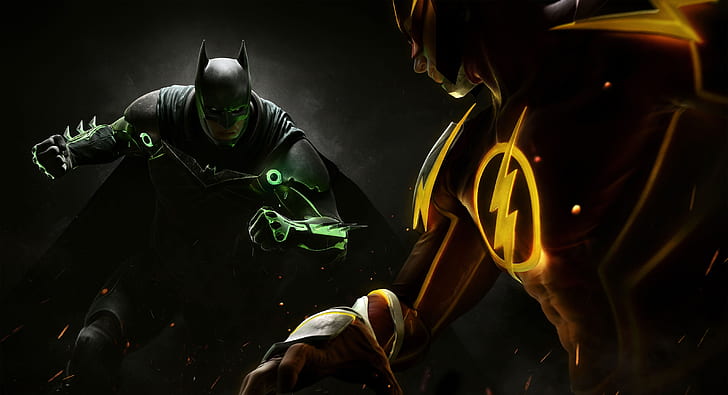Flash games have carved a significant niche in the digital gaming landscape, captivating players with their accessible and engaging gameplay. Emerging in the late 1990s, these browser-based games utilized Adobe Flash technology, allowing users to enjoy interactive experiences without the need for high-end hardware or downloads. This evolution not only democratized gaming but also laid the groundwork for countless iconic titles that defined an era.
Characterized by their simple mechanics, vibrant graphics, and often addictive gameplay, flash games fostered a thriving online community. From puzzle and platformer genres to action and adventure, these games offered something for everyone, making them a staple of casual gaming. As we explore the landscape of flash games, we uncover a vibrant history rich in innovation and creativity.
Overview of Flash Games

Flash games have played a significant role in the evolution of online gaming, providing a platform for both casual and dedicated gamers since their inception. Originating in the late 1990s, these browser-based games have allowed users to engage in interactive entertainment without the need for extensive downloads or installations, making gaming more accessible to a wider audience.
The history of Flash games can be traced back to Adobe Flash, a powerful software used to create animations, web applications, and games. Flash technology gained prominence due to its ability to deliver rich multimedia content over the internet. As web speeds improved and broadband became commonplace, developers embraced Flash to craft engaging and visually appealing games. This evolution led to a surge in game development that transformed casual gaming into a mainstream phenomenon.
Characteristics of Flash Games
Flash games are defined by several key characteristics that distinguish them from traditional video games. Understanding these traits is essential to appreciating their impact on the gaming landscape:
- Accessibility: Flash games can be played directly within web browsers, eliminating the need for complex installations. This ease of access has contributed to their popularity among casual gamers.
- Simple Graphics: Most Flash games feature straightforward graphics and animations, which allows for quicker development and a focus on gameplay rather than high-fidelity visuals.
- Short Play Sessions: Typically designed for short bursts of entertainment, Flash games are ideal for players looking to enjoy quick gaming experiences during breaks or idle moments.
- Diverse Genres: The Flash gaming scene encompasses a wide array of genres, from puzzle and strategy games to action and simulation, catering to various player preferences.
- Community Engagement: Many Flash games incorporate social features, allowing players to compete against friends, share scores, or collaborate on challenges, thus enhancing the communal aspect of gaming.
The impact of Flash technology on gaming cannot be overstated. It democratized game development, allowing independent creators to publish their work without the barriers often associated with traditional game publishing. The rise of platforms like Newgrounds and Kongregate further exemplified this trend, providing a dedicated space for developers and players to interact and share content.
“Flash games have transformed casual gaming into a mainstream phenomenon, making interactive entertainment accessible to everyone.”
In summary, Flash games have not only pioneered the way games are consumed online but have also fostered a vibrant community of developers and players that continues to influence the gaming industry today. Their simple yet engaging design and the accessibility they offer have left a lasting legacy in the realm of digital entertainment.
Popular Flash Game Genres: Flash Games

Flash games have gained immense popularity due to their accessibility and engaging gameplay. These games span various genres, each offering unique mechanics and experiences. From action-packed shooters to brain-teasing puzzles, the diversity in flash gaming captivates a wide audience, making it a staple of casual gaming culture.
In this segment, we explore the most popular genres of flash games, highlighting their distinctive gameplay mechanics and influential titles that have shaped the landscape of online gaming. Understanding these genres not only showcases the creativity involved in game design but also illustrates the evolution of interactive entertainment.
Action Games
Action games are characterized by fast-paced gameplay, often involving challenges that require quick reflexes and precise control. Players navigate through levels filled with enemies, obstacles, or time constraints. Popular examples in this genre include “Super Mario Flash,” where players control Mario through various levels, and “Boxhead,” a shooter game featuring zombies.
The gameplay mechanics in action games generally focus on:
- Real-time challenges that test reflexes and timing.
- Combat mechanics, including melee and ranged attacks.
- Level progression, often culminating in a boss fight.
Influential titles in this genre have set the standard for action games:
- “Super Mario Flash” – A platformer that allowed players to create and share levels.
- “N” – A ninja platformer that emphasized precision and speed.
- “Boxhead” – An iconic shooter that popularized cooperative gameplay in flash games.
Puzzle Games
Puzzle games challenge players’ problem-solving skills and cognitive abilities. These games often require players to think critically or strategically to progress through levels. Notable examples include “Bubble Shooter,” where players match colors to clear bubbles, and “Bloons,” which involves popping balloons using darts.
The common gameplay mechanics found in puzzle games include:
- Logic-based challenges requiring strategic thinking.
- Timed levels or moves to increase difficulty.
- Progressive difficulty, introducing new elements as players advance.
Key titles that have influenced the puzzle genre are:
- “Bejeweled” – A match-three game that helped popularize mobile gaming.
- “Cut the Rope” – A physics-based puzzle game that emphasizes interaction with objects.
- “Tetris” – The classic block-matching game that remains a timeless favorite.
Adventure Games
Adventure games focus on storytelling, exploration, and puzzle-solving. Players often embark on quests, interacting with characters and environments. Examples such as “The Last Stand” highlight survival elements, while “Samorost” incorporates artistic visuals and music.
Gameplay mechanics in adventure games typically involve:
- Exploration of environments to uncover clues and items.
- Puzzle-solving that often requires item combinations or logical reasoning.
- Dialogue interactions with non-playable characters to drive the story.
Influential titles in this genre that have captured players’ imaginations include:
- “Samorost” – Known for its unique art style and atmospheric storytelling.
- “The Last Stand” – A blend of adventure and survival mechanics with a post-apocalyptic theme.
- “Monkey Island” – A classic point-and-click adventure that defined the genre.
Simulation Games
Simulation games replicate real-world processes or activities, allowing players to experience scenarios in a controlled environment. “FarmVille” and “Bloons Tower Defense” are popular examples that engage players in strategic planning and resource management.
The gameplay mechanics typically found in simulation games include:
- Resource management involving economic strategies.
- Progression systems that reward players for time investment.
- Realistic simulations of real-life activities, from farming to city-building.
Influential titles in simulation that have defined the genre include:
- “FarmVille” – A social farming simulation game that became a viral sensation.
- “SimCity Classic” – A city-building simulation game that established a franchise.
- “Bloons Tower Defense” – A tower defense game that introduced strategic gameplay elements.
The Decline of Flash Games
The decline of Flash games marks a significant shift in the online gaming landscape, as these once-popular titles have seen diminishing returns over the years. Factors contributing to this decline range from technological advancements to evolving player preferences. Understanding these reasons provides insight into the gaming industry’s trajectory and highlights the impact of Flash games on modern gaming.
The transition from Flash to more robust platforms like HTML5 has been a pivotal moment in the gaming community. Flash, long celebrated for its accessibility and ease of use, faced challenges that led developers to seek alternative methods of game creation. The rise of mobile gaming and the growing demand for cross-platform capabilities prompted many developers to pivot away from Flash. HTML5 emerged as a direct competitor, offering improved performance, better security, and compatibility across various devices without the need for additional plugins, which Flash required.
Reasons for Decline in Popularity, Flash games
Several key factors contributed to the decline in the popularity of Flash games. These include:
- Technological Limitations: Flash games were often hindered by performance issues, especially on mobile devices, limiting their appeal in a market that increasingly favored mobile gaming.
- Security Vulnerabilities: Flash has a history of security flaws, which made it less appealing for developers and users concerned about potential exploits.
- Shift to Mobile Platforms: With the surge in smartphone usage, players gravitated towards mobile gaming apps that offered richer experiences and better graphics.
- Browser Support Changes: Major web browsers began phasing out support for Flash, leading to a decrease in accessibility for casual gamers.
Transition from Flash to HTML5 and Other Platforms
The transition away from Flash involved a significant migration to HTML5 and other gaming technologies. HTML5 provided a more versatile framework for game development, allowing for a seamless transition across various devices and platforms. The benefits of this transition included:
- Cross-Platform Compatibility: HTML5 games can run on any device with a web browser, offering greater accessibility to players.
- Enhanced Performance: Games built with HTML5 often load faster and run smoother compared to their Flash counterparts.
- Improved Security: HTML5 does not rely on plugins, reducing the risk of security vulnerabilities that plagued Flash.
- Rich Multimedia Support: HTML5 allows for better integration of audio and video, enhancing the overall gaming experience.
Legacy and Impact of Flash Games on Modern Gaming
Despite their decline, Flash games left an indelible mark on the gaming industry. They played a crucial role in shaping the landscape of online gaming, fostering creativity and innovation among independent developers. Some key points regarding their legacy include:
- Indie Game Development: Flash provided an accessible platform for aspiring game developers to create and share their work without the need for significant funding.
- Community Engagement: Flash games facilitated the growth of online gaming communities, where players could connect, compete, and share experiences.
- Cultural Impact: Many Flash games became cultural phenomena, influencing game design and inspiring future titles across various genres.
- Foundation for Modern Browsers: The challenges faced by Flash prompted browsers to enhance their support for modern web standards, paving the way for a richer online experience.
Flash games may have faded from mainstream use, but their influence on game development and the online culture of gaming endures.
Last Recap
In summary, flash games represent a fascinating chapter in the history of gaming, marked by their rise and eventual decline due to technological advancements. The transition from Flash to HTML5 and other platforms has shaped the current gaming environment, yet the legacy of flash games continues to resonate. These games not only entertained millions but also influenced the design and mechanics of modern video games, proving that their impact is far from forgotten.

